Nasturtium leaves are completely edible, and have a spicy, peppery bite similar to arugula.
When used in place of basil, nasturtium will add a radish-type 'bite' and a very slight earthy flavor to the pesto. It's hard to pick out when added to a pasta or soup, but you could use a mix of basil and nasturtium leaves if you want more of a traditional pesto flavor.
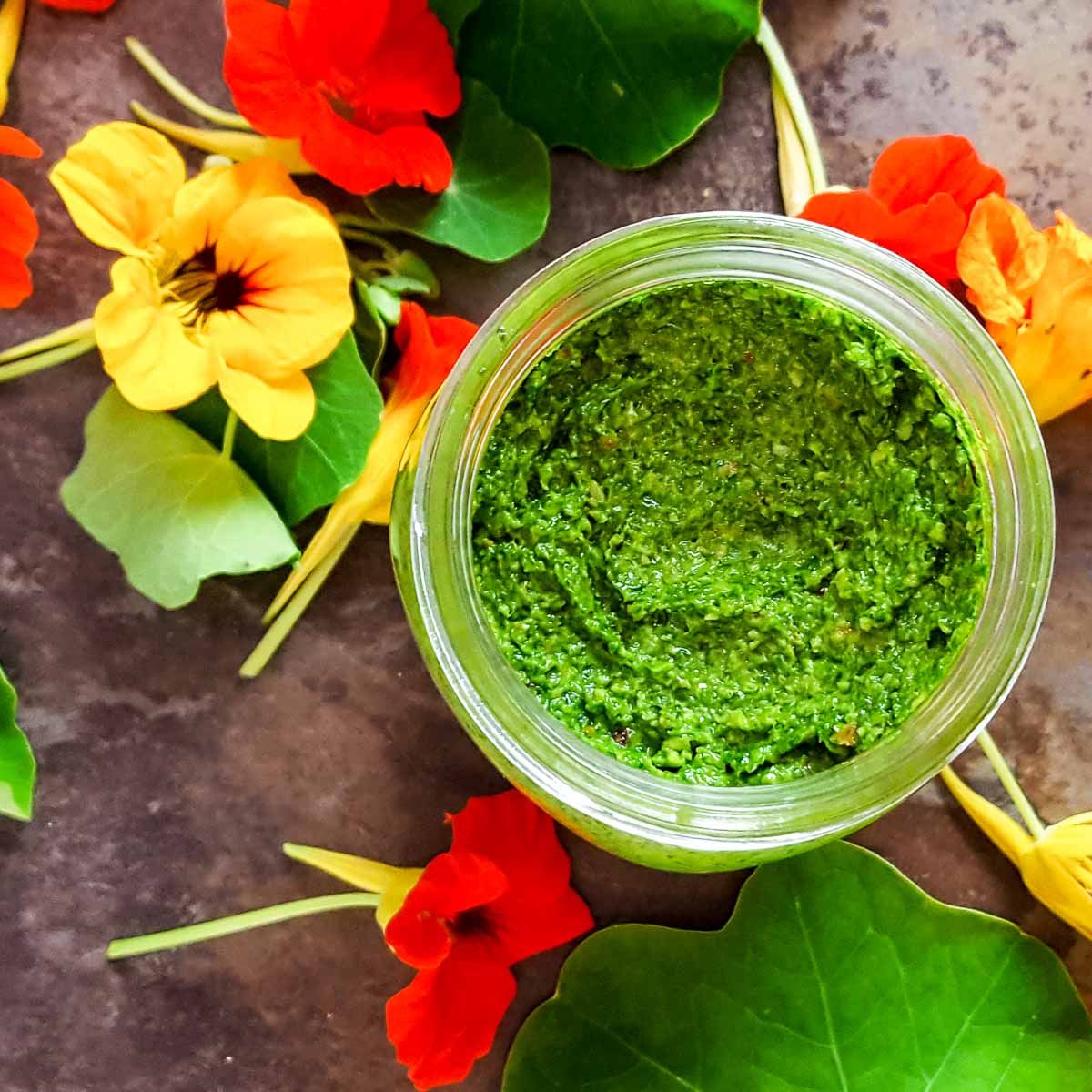
This is a humble little sauce, and I don't want you to think it will win any awards or turn you into a celebrity chef. However, my friends always ask to take some of my nasturtium plants home after trying this sauce, along with the recipe.
If you grow nasturtium in your garden, this is a great way to use it up. You can also freeze this to brighten up a meal in the middle of winter.
Recipe
Ingredients
- 50 large nasturtium leaves or twice as many if small
- ¼ cup pistachios or favorite nut
- ½ cup olive oil
- ½ cup Parmesan cheese
- 1 pinch red pepper optional
- salt and pepper to taste
Instructions
- Wash the nasturtium leaves and shake them dry (they can be slightly wet). Toast the nuts (it intensifies their flavor and I love it) - put them in a dry pan over medium heat, stirring every 30 seconds or so. Cook for 2-3 minutes - until they start to smell good. Then take them off the heat, or they will burn (fast!)
- Fill your food processor up ¾ of the way, loosely, with leaves. Blend until they are chopped. Add more leaves, blend. Continue this until all of the leaves are blended up.
- Add in the pistachios and blend until finely chopped.
- Add in the cheese, red pepper and half the oil. Blend.
- Add more oil until it's the desired consistency. This will highly depend on how much nasturtium you used.
- Taste. Add salt, black pepper, more nuts or more cheese until you like how it tastes.
Notes
Nutrition
Recipe notes & tips
- Nuts: use any nut you like or have lying around. I can't picture a nut that wouldn't work well.
- Working with nasturtium: As explained in "How to use nasturtium," all parts of the plant are edible. While the flavor is pretty similar, there are slight differences.
- Using stems: nasturtium stems work great in this pesto. But you might want to roughly chop them up so long stems don't get tangled in the food processor (thanks to Victoria's suggestion in the comments).
- Free form pesto: pesto is really one of those things you taste as you go. Then adjust, adding more of whatever you think is missing. You can't go wrong when you just follow your instincts.
- If something feels missing: I like to brighten it up when I add it to pasta, with lemon zest and lemon juice.
- Early vs late-season leaves - In spring, the leaves are smaller, more tender, and more mild. If the leaves taste too strong or are too tough later in the season, you could try blanching them first. You Grow Girl has instructions for that.
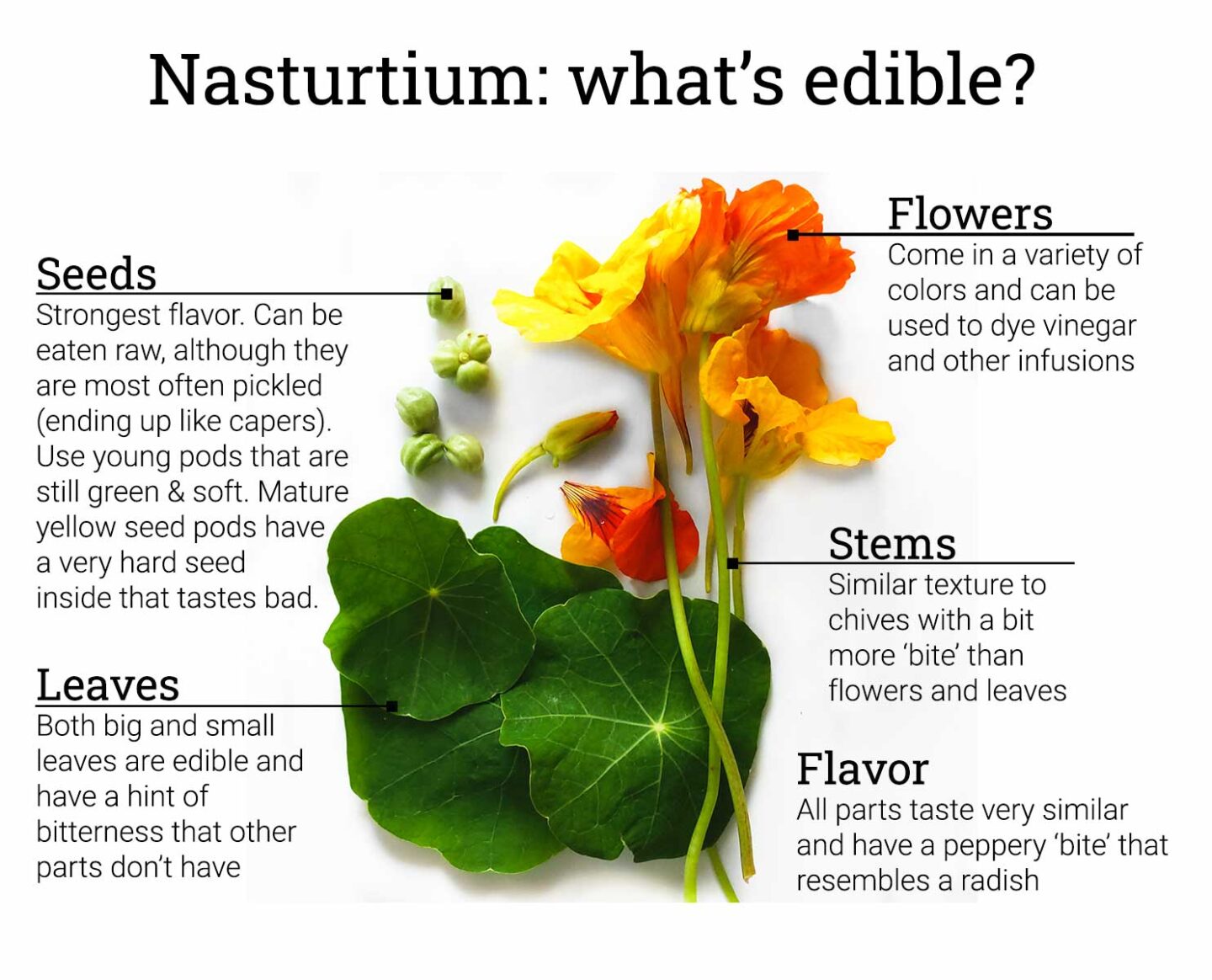
Other nasturtium recipes & resources
How do you use nasturtium?
Every year I get overwhelmed with Nasturtium that regrows from the past year. I'm always looking for ways to use it, rather than cutting it back and composting it. Have you found other ways to use it? Share in the comments.

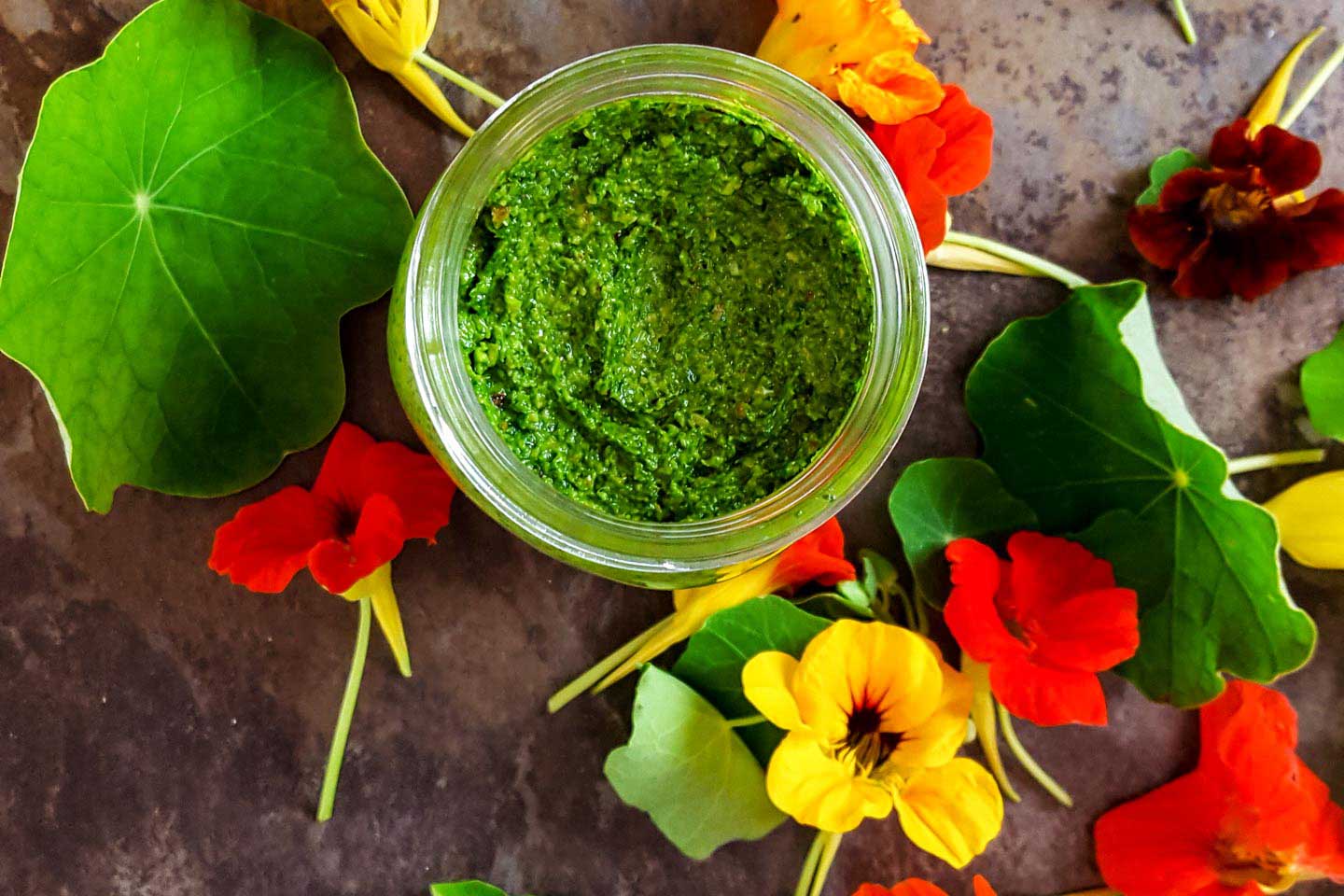

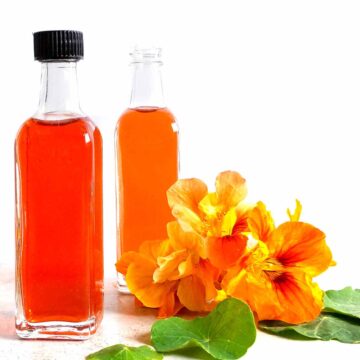
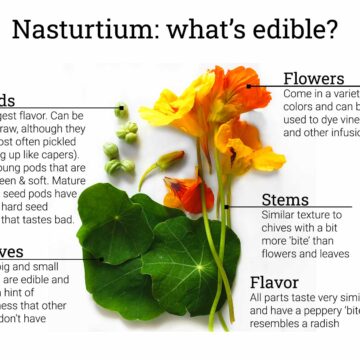
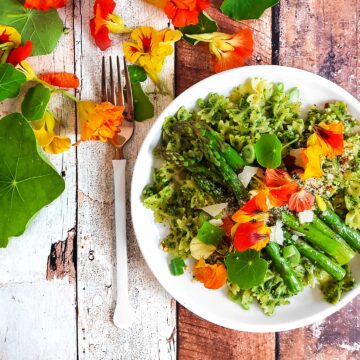

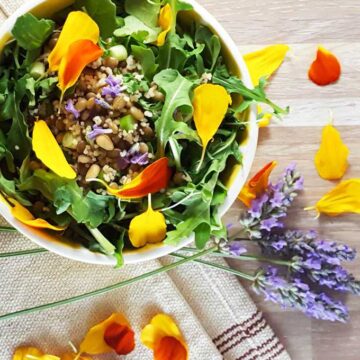
Ian buchanan says
I’m thrilled to find your recipe for nasturtium pesto
Basil pesto costs a lot
Vee says
Glad to have helped, and you're right! Store bought pesto is quite expensive and often not super flavorful (in my experience). You've inspired me to work on photographing and publishing a basil pesto recipe that uses up basil from the garden (because store-bought fresh basil is also expensive).
Lee says
I normally make some wild garlic (everything) pesto and I decided to add a 50/50 mix of wild garlic/nasturtium leaves (I started to grow it late February for the greenhouse as a trap crop and I now have 4 huge nasturtiums in there... Just as the self-seeded ones in the garden are starting to establish).
The pesto was beautiful with just a little peppery kick to it.
The recipe is just the bog standard pesto recipe with the only Chang being the different types of leaves.
Vee says
This sounds delicious. When you say "wild garlic (everything)" do you mean everything seasoning? That would be a very fun take - thanks for sharing.
Liz says
I used a vegan seed Parmesan (sunflower seeds, nutritional yeast, pumpkin seeds) and walnuts and it turned out great. I did add a splash of lemon juice to round out the flavour.
I tried to pinch a red pepper and that didn't seem right. After googling I tried red pepper flakes and that seemed to work ok.
Vee says
This sounds incredible. Thanks for sharing your variation with me (and other readers here).
JoNan says
Such a good idea for using my nasturtium! I added a little bit of basil, roasted garlic, made it vegan by using my homemade vegan "parmesan" cheese, and used pine nuts. Yum!
Vee says
Sounds delicious. Do you have a link to the vegan Parmesan? I'd love to add it to the post for other people to try 🙂
Nico | yumsome food and travel says
Using nasturtium leaves for pesto is such a great idea, isn't it? Yours looks wonderful!
I echo what you say about them being great companion plants for squashes. They're also very good at hiding young kale plants from greedy pigeons!
If you want a tried and tested vegan parm recipe that really works, here's mine. Enjoy!
https://www.yumsome.com/how-to-make-vegan-parmesan/
Vee says
Hello to another gardener and thanks for sharing the tips and recipe 🙂
Greta says
Nasturtium grew like a weed with some pumpkins I planted. I made this pesto and served it with salmon and mashed pumpkin (that looked like a pumpkin but tasted like butternut squash. Fantastic!
Vee says
That sounds delicious. I have a nasturtium that also grows like a weed by my super-cute single-serving sized butternut squash. Not sure if you planted it by your pumpkins on purpose, but in case you didn't know: they are a companion plant to ward off squash bugs 🙂
Victoria C says
This is awesome! I used the leaves and stems, chopping the stems so the processor didn't become a tangle of vines. I used a calabrian chili sauce to give it a bigger kick (which it did need - thanks for suggestion). Deeelish!
Vee says
Chopping the stems is an excellent suggestion, I'm adding that to the post. Thank you. And that chili sauce addition sounds amazing.
Karen Aquino says
In the instructions you mention red pepper, but there is no red pepper on the ingredient list. Do you really put red peppers in this pesto?
Vee says
I am so sorry - I did say to add red pepper in the instructions but didn't list it in the ingredients. I updated the recipe now. My advice: start with a pinch of red pepper. After blending it, taste, and add more if desired.
Vee says
I updated the recipe to include the pinch of red pepper in the ingredients. Thanks for taking the time to comment, I didn't catch that omission myself.
Sonia says
I’m confused because the ingredients don’t say anything about red Pepper but the instructions do. Can you clarify please?
Dani says
Finally, a way to use up my nasturtium. This was so good. I might add some herbs to it next time too.
Vee says
Sounds like a great idea. Let me know what you add and how it turned out.